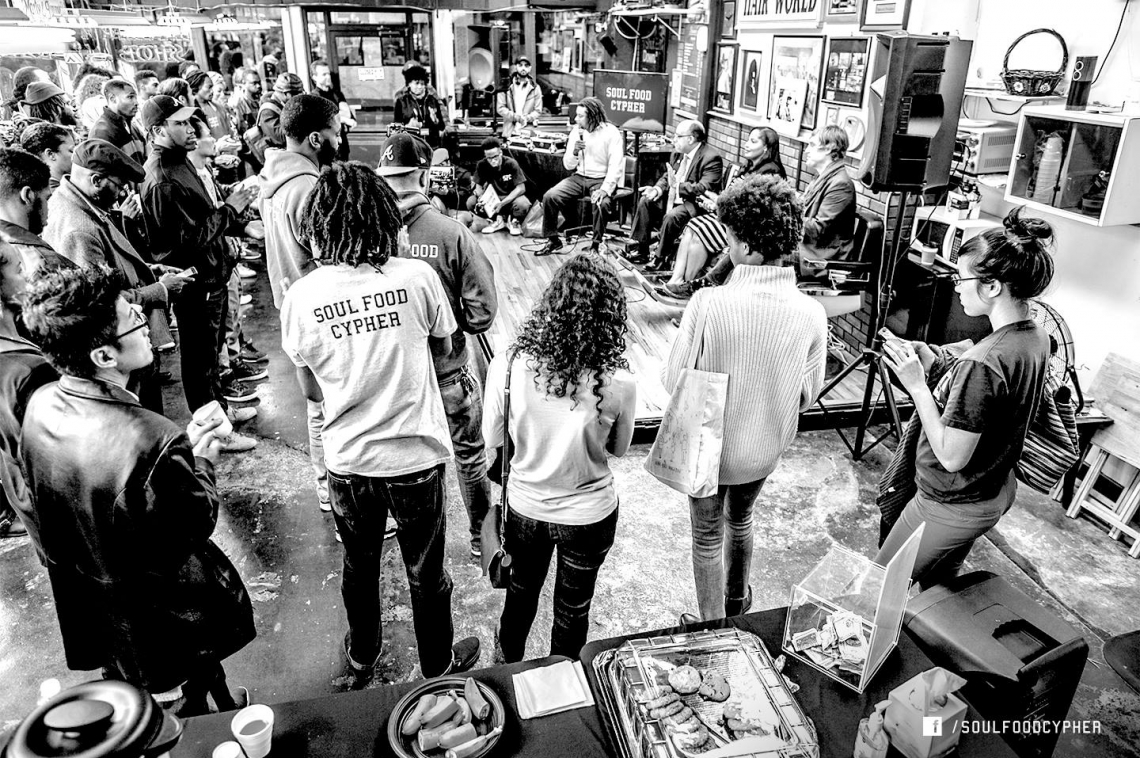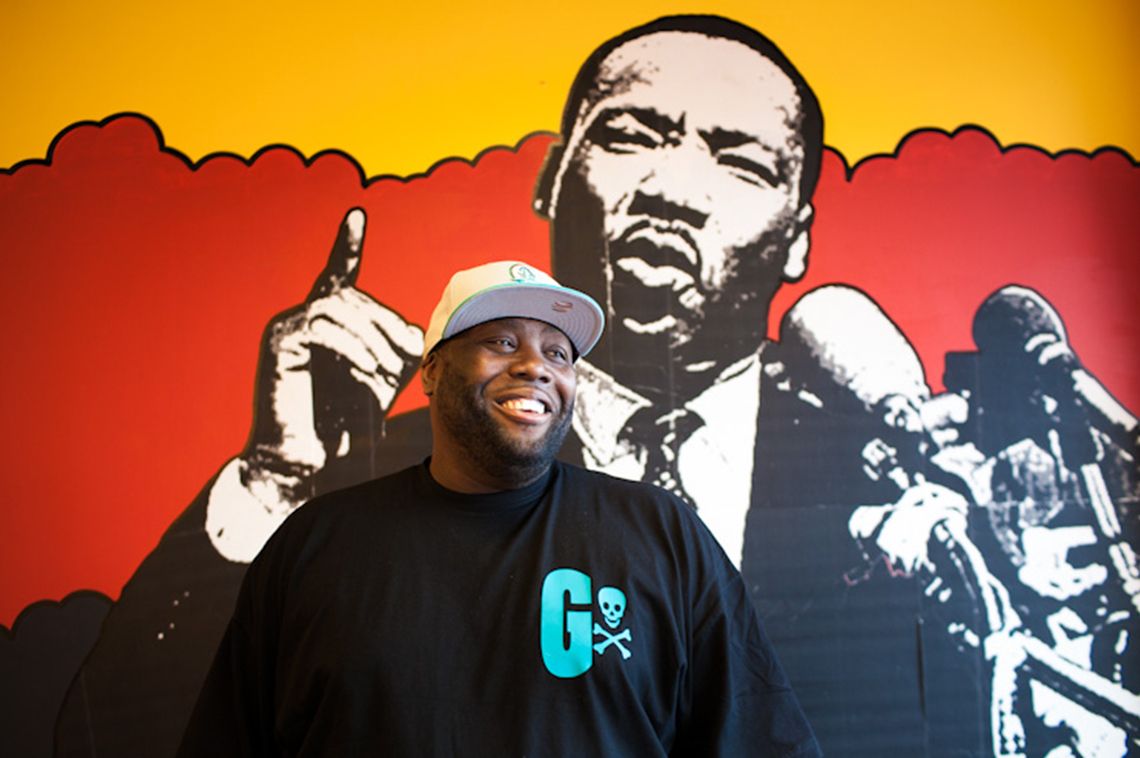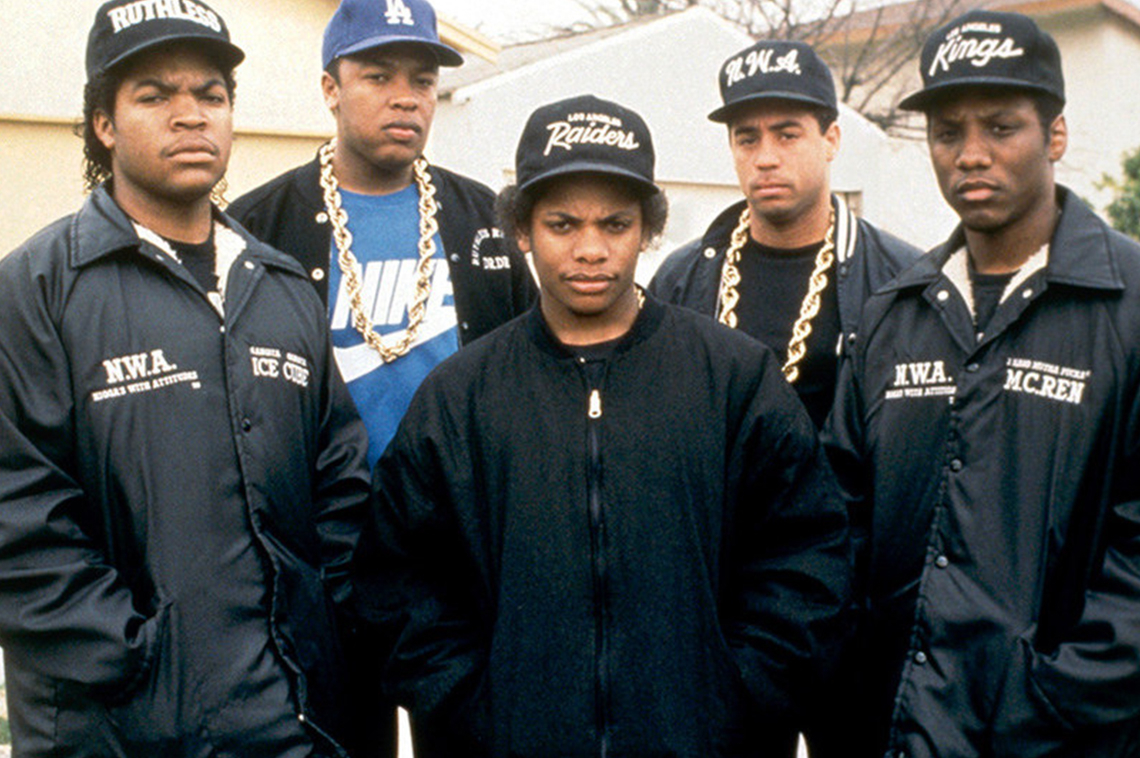


For the past five years, I’ve had the honor and privilege of serving as Soul Food Cypher’s founding Executive Director. SFC is a community based arts organization that utilizes freestyle rap and lyricism to transform communities and individuals. In the Summer of 2015, Soul Food Cypher was honored to receive a creative placemaking grant from ArtPlace America. ArtPlace invests in arts-based strategies to help achieve place-based outcomes in order to reposition arts and culture as a core sector of community planning and development. Creative Placemaking ultimately addresses “how the arts can improve the quality of a place through social offerings and aesthetics that positively impact that place’s people, activities, and values.”
No pun intended, but Creative Placemaking has gotten a bad rap in some circles. Critics of this work, cite successful implementation often leads to Gentrification. In Soul Food Cypher’s application to Artplace, we were very cognitive of this and addressed this directly in our submission.
Since receiving this grant, we have utilized the power of the cypher to bridge longstanding residents and newcomers to Atlanta in the quickly gentrifying neighborhood of Old Fourth Ward. Through activations in public places such as Atlanta’s Streetcar, Sweet Auburn Curb Market, Block Parties, and Barbershops we lead important and open conversations around the city’s civic, social, and economic future.
In midst of us doing our work, I began to personally wonder - Were we one of the first to utilize the craft of rap as a form of what’s been coined creative placemaking? What is Hip-Hop’s relationship with Creative Placemaking?
What is Hip-Hop's relationship with Creative Placemaking?
In commercial rap music, skills on the mic are nearly equal to where you call home. From Cut Master DC proclaiming “Brooklyn’s in the house” in the early 1980’s to Jermaine Dupri rolling out the “Welcome to Atlanta” door mat to the genre’s new home in 2000 - proclaiming and establishing place has always been essential in rap music.
As often the case, the rougher the area, the more authentic and appealing to listeners. No other song (or album) exemplifies this more than N.W.A’s Straight Out of Compton. This 1988 track is a mantra that evokes inclusive pride from an urban city, like so many others, left abandoned by white flight during the 1950’s. The album features themes that read out like tale-tale symptoms of a community impacted by exclusion, discriminatory policies (read policing), and oppression.
Like many Millennials and Gen X’ers, I grew up listening to these witty tales of grandeur set in urban centers throughout the United States. With an ironic twist of fate, it was these same tales that proved appealing to these generations...The city was where all the action was and that’s where we wanted to be.
The rise of commercial rap in the 90’s coincided with major cities (i.e. New York and Washington D.C.) receiving a surge of young creatives in the 00’s. Rap music, for better or worse, has played a role in introducing and promoting city life to an entire generation and attracting them to prominent urban cores. This, in addition to other factors, has ultimately lead to major demographic shifts in cities and the unintentional effect of pushing the very people who culturally made it appealing - out.
I’ve decided to dive deeper to explore on a city by city base some of the creative placemaking songs and the changes the city has experienced since the release of these songs.
What better start than my hometown and the community that I work day in and day out?
Atlanta, GA
In late 2016, native Atlantan Donald Glover, creator of the critically acclaimed show “Atlanta”, dropped a masterpiece that no one was expecting. “Awaken, My Love”, released under his musical moniker Childish Gambino, is an aptly titled resurrection of the P-Funk sound pioneered by the legendary George Clinton. These musicians not only share in soundscape but symbolically with place-based inspiration.
Clinton and his band Parliament, released the 1975 Chocolate City album whose title track and namesake was a love letter to the city of Washington D.C., which was the quintessential “CC” in 1970’s America. Chocolate Cities are large metropolitan areas that are majorly populated by African-Americans who have influence politically, culturally, and economically. While this song is aimed directly at Washington D.C., Clinton mentions other Chocolate City’s and prominently proclaims “… And we’re working on Atlanta.”
Well… Atlanta was got. Since 1973, the city of Atlanta has consistently elected black mayors, African-American businesses have brought in major revenue to the city, and Atlanta became rap music’s center of gravity in the early 2000’s.
Even with these great strides, Atlanta could not escape what author Alan Ehrenhalt has coined as “demographic inversion.” Where gentrification describes changes in a specific neighborhood, demographic inversion describes “the rearrangement of living patterns across an entire metropolitan area, all taking place at one time.” This usually as Ehrenhalt points out, “means the replacement of poorer minority residents by more affluent white residents.” According to the US Census, the city of Atlanta lost 13% of it’s black population from 1990 to 2010. In this same time frame, the Anglo population increased 17%. With these drastic changes Atlanta has transformed from what George Clinton called a “Chocolate city with Vanilla suburbs” to the opposite - an Oreo.
While a major watershed moment, the 96’ Olympics ushered in an era of displacement in Atlanta. In preparation for and after the games, many of the city’s public housing facilities were torn down and reconstructed as mixed-income developments. However, many facilities weren’t converted and those residents found themselves moving far out the city limits in search of affordable housing. Unfortunately, prosperity did not follow. As reported by WABE, “Between 2000 and 2013, poverty in Atlanta’s suburbs had the highest rate of change of any metro region of its size.” In Gwinnett County alone the poverty rate was reported 4% in the 1990 census. As of 2015, this figure has more than tripled to 12.6%.
It aint where you from, it's where you at
Interestingly, these demographic shifts can be heard in the rap music in the region. A great example of this is Migo’s “Highway 85.” This track sonically references NWA and the artist(s) draw attention to this in the first lines of the song. However, what’s more interesting is the exclamation, “Take it back to the North Side!” The North side they are referring to is Gwinnett County, the above-mentioned suburb just north of the City of Atlanta. In the 90’s this would be the last place to expect a rapper to shout out. Out of the majority of Atlanta suburbs, this one experienced some of the most dramatic shifts. In 1990 Gwinnett County was 90% anglo. However, 2015 Census data has revealed Gwinnett county to be majority-minority.
These changes are not only reflected on the Northside but the Southside as well. In Waka Flocka Flame’s 2010 hit, “Oh let’s do it” he proclaims “… But that happen often off in Riverdale, Georgia/ You gonna pay the life you live off in Riverdale, Georgia.” Clayton County, which houses the city of Riverdale, has experienced major shifts in population similar to Gwinnett County. In 1990, the county reported a 24% black population. By 2016, the county reported 65% of it’s residents to be black.
These major shifts in the region remind me of Rakim’s track “In the Ghetto” and his legendary line, “It ain’t where you from, It’s where you’re at.” Because of major shifts in affordable housing policy and urban development, Rakim’s words were prophetic of the many changes in America’s “Ghettos” today. His word’s warned, where you’re from doesn’t matter in comparison to controlling your destiny and the option of choosing where you want to live. Many of those who have claimed Atlanta for years, can no longer to afford to live in the City they have called home and helped build.
Young Artists are often seen as the seeds of Gentrification. Regardless of medium, the arts are what make cities beautiful and desirable places to live. Before young creatives began moving to inner cities throughout the United States and changing them inside out, rappers were some of the original artists to promote urban centers. Rakim was farsighted in seeing many of the issues of inequality and affordable housing that effect artists throughout the country. In the same song, he delivers a manifesto: “No more props, I want property in every borough, nobody's stopping me/ Because I'm thorough, rhymes are making real estate for me to own wherever I bless a microphone.”
As we wrap our creative placemaking grant cycle, Rakim’s words ring in my mind with strong resonance. Having connected residents, artists, and elected officials in both rhyme and reason, I know Atlanta has the creative community to rival other global cities and the collective ideas to solve our biggest challenges ahead – the largest and most pervasive being generational income inequality. As a city, Atlanta has an opportunity to embrace emcees not only as legitimate artists, but as the city’s greatest documentarians, teachers, and storytellers as well. The narrative they provide of Atlanta, is a strikingly real indicator of the effects of policy and will ultimately be one of the long lasting historical records of our city. Additionally, artists themselves have the responsibility of investing - large and small, financially and politically - in the very places they promote.
In all, a freestyle cypher is simply a microcosm of our community and city. It’s church, school, and theatre, “at the same damn time.” By ensuring everyone has a place and a voice in the cypher, it always makes it a more enjoyable experience for everyone involved. What makes us think cities are any different?
Links below are to mixes of songs that exemplify Creative Placemaking in Rap Music by Alexander Acosta.
Atlanta (Some explicit Language, NSFW)
--
About the writer
Alexander Acosta is co-founder and Executive Director of Soul Food Cypher. Soul Food Cypher is a community arts organization that builds individuals and communities through the power of freestyle rap by hosting cypher events, educational services, and workshops throughout the country.
The roots of the SFC trace back to 2011, when Acosta began mentoring teens at the Whitefoord Computer Clubhouse in East Atlanta. Originally, he hosted photography workshops but quickly found he connected with the teens in more meaningful and real ways when they would rhyme during freestlye cypher sessions at the clubhouse. Experiencing the teens brilliance and improvisational ingenuity, he became a believer in their ability to improve themselves and their communities through their words. Concurrently, he was having similar cypher sessions with his closest friends who happened to be highly skilled professionals and looking to broaden these freestyle sessions. By bringing these individuals together and bridging this generational and socio-economic gap, Soul Food Cypher was born in early 2012.
As Executive Director, he has lead Soul Food Cypher from the basement of Wonderroot to stages at the High Museum of Art, A3C Music Festival, and Coca-Cola Headquarters. Maintaining it’s educational roots and core, he has utilized the cypher format to develop and execute workshops at Emory University, Atlanta Neighborhood Charter School, and the Boys and Girls Club of America.
Outside of the cypher, Acosta works as Director of Managed Services at Acosta Technologies. He teaches photography classes at the Atlanta School of Photography and Piedmont School in Brookhaven. Prior to his career as a Community Leader, he was a staff and freelance photojournalist. He has shot for publications The USA Today, Atlanta-Journal Constitution, and the Palm Beach Post.
As an arts advocate, he proudly sits on Air Serenbe’s National Advisory Council and formerly served on C4 Atlanta’s board.
Alex will be at the fifth annual Atlanta Studies Symposium on April 26, 2017. The symposium will be held at the Woodruff Library of the Atlanta University Center and focuses on the theme of "Rethinking Equity in Atlanta." For more information click here.





